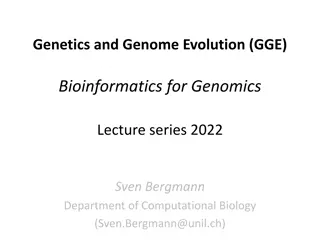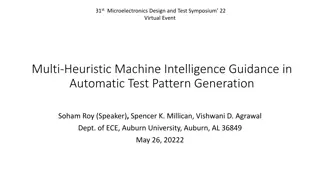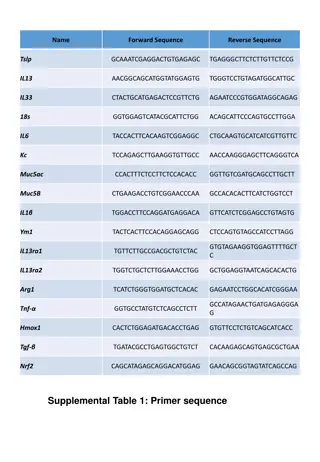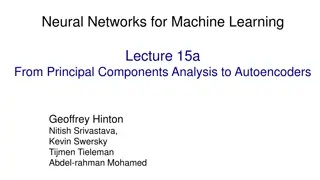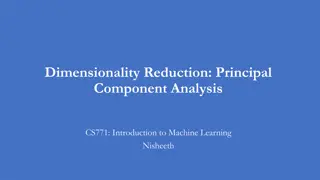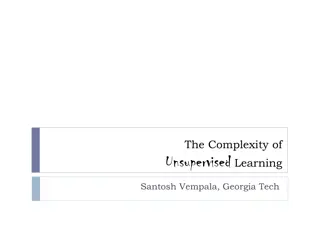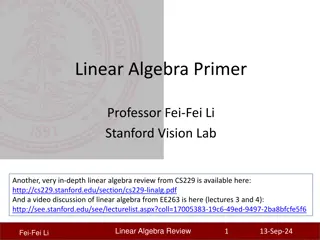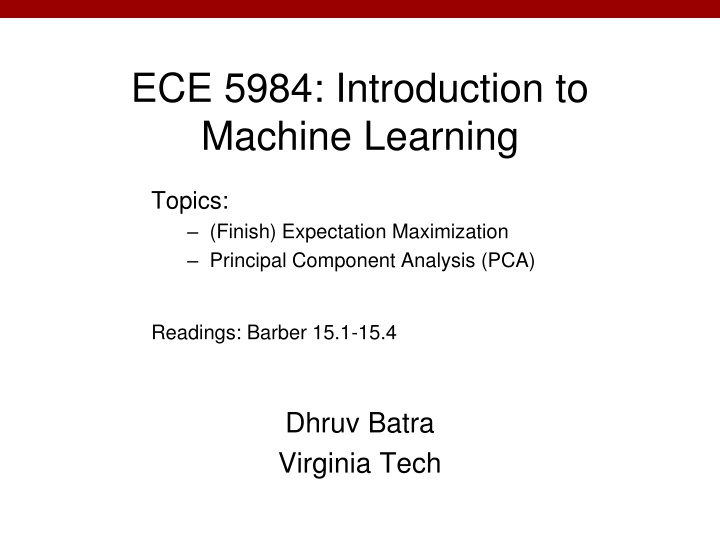
Unsupervised Learning Techniques Overview
Dive into the world of unsupervised learning with topics like Expectation Maximization, Principal Component Analysis, and K-means algorithms. Discover the essence of soft K-means, GMM, and EM techniques as essential tools in machine learning. Don't miss the chance to explore these powerful methods in depth with expert insights and resources.
Download Presentation

Please find below an Image/Link to download the presentation.
The content on the website is provided AS IS for your information and personal use only. It may not be sold, licensed, or shared on other websites without obtaining consent from the author. If you encounter any issues during the download, it is possible that the publisher has removed the file from their server.
You are allowed to download the files provided on this website for personal or commercial use, subject to the condition that they are used lawfully. All files are the property of their respective owners.
The content on the website is provided AS IS for your information and personal use only. It may not be sold, licensed, or shared on other websites without obtaining consent from the author.
E N D
Presentation Transcript
ECE 5984: Introduction to Machine Learning Topics: (Finish) Expectation Maximization Principal Component Analysis (PCA) Readings: Barber 15.1-15.4 Dhruv Batra Virginia Tech
Administrativia Poster Presentation: May 8 1:30-4:00pm 310 Kelly Hall: ICTAS Building Print poster (or bunch of slides) Format: Portrait Make 1 dimen = 36in Board size = 30x40 Less text, more pictures. Best Project Prize! (C) Dhruv Batra 2
Administrativia Final Exam When: May 11 7:45-9:45am Where: In class Format: Pen-and-paper. Open-book, open-notes, closed-internet. No sharing. What to expect: mix of Multiple Choice or True/False questions Prove this statement What would happen for this dataset? Material Everything! Focus on the recent stuff. Exponentially decaying weights? Optimal policy? (C) Dhruv Batra 3
Recap of Last Time (C) Dhruv Batra 4
K-means 1. Ask user how many clusters they d like. (e.g. k=5) 2. Randomly guess k cluster Center locations 3. Each datapoint finds out which Center it s closest to. 4. Each Center finds the centroid of the points it owns 5. and jumps there 6. Repeat until terminated! (C) Dhruv Batra Slide Credit: Carlos Guestrin 5
K-means as Co-ordinate Descent Optimize objective function: Fix , optimize a (or C) Assignment Step Fix a (or C), optimize Recenter Step (C) Dhruv Batra Slide Credit: Carlos Guestrin 6
GMM (C) Dhruv Batra Figure Credit: Kevin Murphy 7
K-means vs GMM K-Means http://home.deib.polimi.it/matteucc/Clustering/tutorial_html/A ppletKM.html GMM http://www.socr.ucla.edu/applets.dir/mixtureem.html (C) Dhruv Batra 8
EM Expectation Maximization [Dempster 77] Often looks like soft K-means Extremely general Extremely useful algorithm Essentially THE goto algorithm for unsupervised learning Plan EM for learning GMM parameters EM for general unsupervised learning problems (C) Dhruv Batra 9
EM for Learning GMMs Simple Update Rules E-Step: estimate P(zi = j | xi) M-Step: maximize full likelihood weighted by posterior (C) Dhruv Batra 10
Gaussian Mixture Example: Start (C) Dhruv Batra Slide Credit: Carlos Guestrin 11
After 1st iteration (C) Dhruv Batra Slide Credit: Carlos Guestrin 12
After 2nd iteration (C) Dhruv Batra Slide Credit: Carlos Guestrin 13
After 3rd iteration (C) Dhruv Batra Slide Credit: Carlos Guestrin 14
After 4th iteration (C) Dhruv Batra Slide Credit: Carlos Guestrin 15
After 5th iteration (C) Dhruv Batra Slide Credit: Carlos Guestrin 16
After 6th iteration (C) Dhruv Batra Slide Credit: Carlos Guestrin 17
After 20th iteration (C) Dhruv Batra Slide Credit: Carlos Guestrin 18
General Mixture Models P(x | z) Gaussian Multinomial Categorical P(z) Categorial Categorical Dirichlet Name GMM Mixture of Multinomials Latent Dirichlet Allocation (C) Dhruv Batra 19
Mixture of Bernoullis 0.12 0.14 0.12 0.06 0.13 0.07 0.05 0.15 0.07 0.09 (C) Dhruv Batra 20
The general learning problem with missing data Marginal likelihood x is observed, z is missing: (C) Dhruv Batra 21
Applying Jensens inequality Use: log z P(z) f(z) z P(z) log f(z) (C) Dhruv Batra 22
Convergence of EM Define potential function F( ,Q): EM corresponds to coordinate ascent on F Thus, maximizes lower bound on marginal log likelihood (C) Dhruv Batra 23
EM is coordinate ascent E-step: Fix (t), maximize F over Q: Realigns F with likelihood: (C) Dhruv Batra 24
EM is coordinate ascent M-step: Fix Q(t), maximize F over Corresponds to weighted dataset: <x1,z=1> with weight Q(t+1)(z=1|x1) <x1,z=2> with weight Q(t+1)(z=2|x1) <x1,z=3> with weight Q(t+1)(z=3|x1) <x2,z=1> with weight Q(t+1)(z=1|x2) <x2,z=2> with weight Q(t+1)(z=2|x2) <x2,z=3> with weight Q(t+1)(z=3|x2) (C) Dhruv Batra 25
EM Intuition (C) Dhruv Batra 26
What you should know K-means for clustering: algorithm converges because it s coordinate ascent EM for mixture of Gaussians: How to learn maximum likelihood parameters (locally max. like.) in the case of unlabeled data EM is coordinate ascent Remember, E.M. can get stuck in local minima, and empirically it DOES General case for EM (C) Dhruv Batra Slide Credit: Carlos Guestrin 27
Tasks x Classification y Discrete x Regression y Continuous x Clustering c Discrete ID Dimensionality Reduction x z Continuous (C) Dhruv Batra 28
Synonyms Principal Component Analysis Karhunen Lo ve transform Eigen-Faces Eigen-<Insert-your-problem-domain> PCA is a Dimensionality Reduction Algorithm Other Dimensionality Reduction algorithms Linear Discriminant Analysis (LDA) Independent Component Analysis (ICA) Local Linear Embedding (LLE) (C) Dhruv Batra 30
Dimensionality reduction Input data may have thousands or millions of dimensions! e.g., images have 5M pixels Dimensionality reduction: represent data with fewer dimensions easier learning fewer parameters visualization hard to visualize more than 3D or 4D discover intrinsic dimensionality of data high dimensional data that is truly lower dimensional
Dimensionality Reduction Demo http://lcn.epfl.ch/tutorial/english/pca/html/ http://setosa.io/ev/principal-component-analysis/ (C) Dhruv Batra 32
PCA / KL-Transform De-correlation view Make features uncorrelated No projection yet Max-variance view: Project data to lower dimensions Maximize variance in lower dimensions Synthesis / Min-error view: Project data to lower dimensions Minimize reconstruction error All views lead to same solution (C) Dhruv Batra 33



